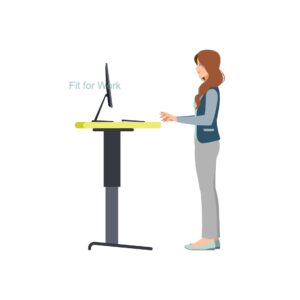You’ve most likely either spotted someone in your office or a colleagues’ office with a sit to stand desk. Sit to stand desks are the latest office hype. One of the main reasons for this, is the increased awareness of improving our overall health. A changeable desk gives the user an option to easily alternate their position from sitting to standing throughout their working day.
However, having an adjustable desk does not automatically mean you will have better posture in sitting or standing. It does not mean that any of our aches and pains will ease or disappear or that our health will improve. Our behaviour and our habits are even more important. You may see some of your colleagues using standing desks but leaning on their desk. In this instance, the user is putting a lot of strain on their lower back. You would actually be in a better position sitting on a well-supported chair with their back fully against the backrest. Learn more about the benefits and drawbacks of the sit to stand desk.
Is a Sit to Stand Desk an Investment?
There are different options on the market to allow the user to work in either a sitting or standing position. A desk converter sits directly on your current desk. It has a user-friendly crank that adjusts the desk from sitting to standing with one quick motion. Whereas, an electrically adjustable desk setup requires removal of the current desk and availability of a power source. At the moment, unfortunately, standing desks and desk converters can be expensive. Yet considering it from a productivity perspective, they can be worth the investment.
Decreases Fatigue and Improves Focus
We always encourage frequent movement, whether sitting or standing. When you sit or stand for long periods at your desk, there is little to keep your energy levels up. It’s also not uncommon to start to slouch into your comfy office chair or hunch forward to lean on your desk. At the same time, letting your mind start to wander if you stay in the one position for too long. Having the option to alter your position frequently; at least every 45 minutes; can help you be more alert, more productive, encourage you to stay in an upright position and reduce, ease or prevent any aches and pains.
Initially, when adjusting to a standing desk you may find it tiring and uncomfortable. Static standing has more stress implications than sitting. This is because you will only be weight bearing through your feet unlike when sitting you will be weight-bearing through multiple areas (backrest, armrest feet and seat).
You may benefit from starting with 5-minute intervals at a maximum of 30 minutes standing a day. The intervals can gradually increase over time. However, even if you feel comfortable standing for long periods of time, we would still urge you to change your position at least every 45 minutes. You don’t necessarily need to sit down but you can incorporate movement. For example, you can walk around your desk, get some water, go to a meeting or go for lunch. We recommend listening to how your body feels and not focusing on standing for a certain timeframe. You may be feeling more tired one day and therefore your standing tolerance may be reduced. It is important to utilize the desk’s sitting and standing options and move as your body needs to.
Improves General Health
Leading a sedentary lifestyle and sitting all day at work can lead to medical issues. It can lead to a greater risk of type 2 diabetes, obesity, cardiovascular disease and cancer. Many office workers try to counteract the negative effects of exercising. However, this does not necessarily make up for it. A standing desk may help some individuals to do more desk exercises like squatting, heel raises and stretches.
However, when standing for long periods there is a risk of developing swollen feet, varicose veins, hip, knee and lower back pain. Wear comfortable shoes, change your posture at least every 45 minutes, ensure your monitor/laptop, keyboard, mouse and other accessories are correctly set up to allow for neutral posture as well as correctly setting the desk height.
How to Get the Correct Desk Height in Standing
Take one step back from your desk. Stand with your feet flat on the ground, hip-width apart. Look straight towards your monitor and relax your shoulder. Bend your elbows to 90 degrees and point your fingers straight out in front of you. Now, without moving, take the one step back towards your desk. Your hands should be on top of your keyboard.
- If your hands are below or at the same level as the desk, the desk is too high and needs to be lowered.
- If your hands are much higher than the keyboard, you need to raise the desk until your hands land onto the keyboard.
- TOP TIP: Try this with your eyes closed. Your body will tell you when you are at the correct height and not your eyes/mind.
In conclusion, there are many benefits of a sit to stand desk. It can be a good investment for your office environment. THE NEXT POSTURE IS THE BEST POSTURE SO KEEP MOVING! Using your sit to stand desk in intervals of sitting and standing, continuing seated and standing desk exercises and taking mini walking breaks around the office will be a step in the right direction for keeping over up good posture and overall health.
Ergonomics Support for Your Company
To learn more about office setup and good ergonomics principles, you can reach out to Fit for Work to talk about how an ergonomic programme within your office can increase productivity, increase staff satisfaction, improve staff retention and reduce sick leave.




